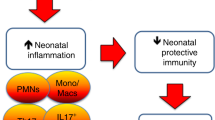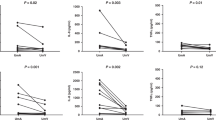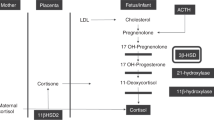Abstract
STUDIES in animals suggest that foetal cortisol (F) may have an important role in foetal lung maturation and the mechanism of parturition. In man the situation is complicated by the greater permeability of the placenta to this hormone1 and its intraplacental conversion to its biologically inactive metabolite, cortisone (E) (refs 2–4). Many other foetal tissues also convert F to E (ref. 5). As a result, human foetal blood contains a relatively large amount of E, and a lower F : E ratio. Recently, we observed that the F : E ratio of amniotic fluid is considerably higher than that of cord serum6. To explore this, the possible influences of the foetal kidney, skin, gastro-intestinal tract, lung and membranes were investigated; only the chorionic membrane was found to convert cortisone to cortisol.
This is a preview of subscription content, access via your institution
Access options
Subscribe to this journal
Receive 51 print issues and online access
$199.00 per year
only $3.90 per issue
Buy this article
- Purchase on Springer Link
- Instant access to full article PDF
Prices may be subject to local taxes which are calculated during checkout
Similar content being viewed by others
References
Migeon, C. A., Bertrand, J. & Gemzell, C. A. Rec. Prog. Horm. Res. 17, 207–237 (1961).
Osinski, P. A. Nature 187, 777 (1960).
Sybulski, S. & Venning, E. H. Can. J. Biochem. Physiol. 39, 203–214 (1961).
Murphy, B. E. P., Clark, S. J., Donald, I. R., Pinsky, M. & Vedady, D. Am. J. Obstet. Gynec. 118, 538–541 (1974).
Pasqualini, J. R., Nguyen, B. L., Uhrich, F., Wiqvist, N. & Diczfalusy, E. J. Stereoid Biochem. 1, 209–219 (1970).
Murphy, B. E. P. 5th Int. Congress of Endocrinology (Hamburg, July 1976). (Abstract).
Murphy, B. E. P. J. Clin. Endocrin. Metab. 27, 973–990, (1967).
Murphy, B. E. P. Nature new Biol. 232, 21–24 (1971).
Murphy, B. E. P. Clin. Res. 24, 661A (1976).
Murphy, B. E. P., Patrick, J. & Denton, R. L. J. clin. Endocrin. Metab. 40, 164–167 (1975).
Sharp-Cageorge, S. M., Blecher, B., Gordon, E. R. & Murphy, B. E. P. New Eng. J. Med. 296, 89–91 (1977).
Murphy, B. E. P. & Campbell, A. C. Res. Steroids 7 (in the press).
Mescher, E. J. et al., J. appl. Physiol. 39, 1017 (1975).
Duenhoelter, J. H. & Pritchard, J. A. Obstet. Gynec. 42, 746–750 (1973).
Burke, R. K., Lundy, L. E., Sisson, T. R. & Fagir, M. J. Obstet. Gynec. 4, 833–836 (1973).
Author information
Authors and Affiliations
Rights and permissions
About this article
Cite this article
PEARSON MURPHY, B. Chorionic membrane as an extra-adrenal source of foetal cortisol in human amniotic fluid. Nature 266, 179–181 (1977). https://doi.org/10.1038/266179a0
Received:
Accepted:
Issue Date:
DOI: https://doi.org/10.1038/266179a0
This article is cited by
-
Mechanisms for establishment of the placental glucocorticoid barrier, a guard for life
Cellular and Molecular Life Sciences (2019)
-
Epithelium of the human chorion laeve in diabetes mellitus
Virchows Archiv A Pathological Anatomy and Histopathology (1984)
-
Development of endogenous glucocorticoids, mineralocorticoids and progestins in the human fetal and perinatal period
European Journal of Clinical Pharmacology (1980)
Comments
By submitting a comment you agree to abide by our Terms and Community Guidelines. If you find something abusive or that does not comply with our terms or guidelines please flag it as inappropriate.



